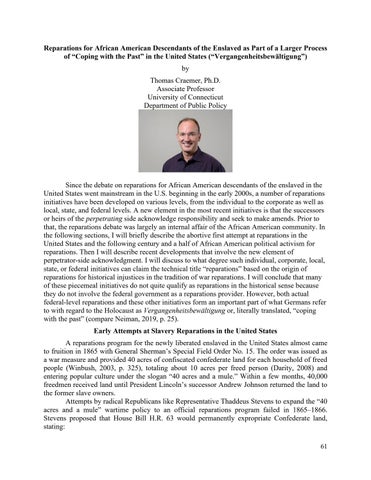Reparations for African American Descendants of the Enslaved as Part of a Larger Process of “Coping with the Past” in the United States (“Vergangenheitsbewältigung”) by Thomas Craemer, Ph.D. Associate Professor University of Connecticut Department of Public Policy
Since the debate on reparations for African American descendants of the enslaved in the United States went mainstream in the U.S. beginning in the early 2000s, a number of reparations initiatives have been developed on various levels, from the individual to the corporate as well as local, state, and federal levels. A new element in the most recent initiatives is that the successors or heirs of the perpetrating side acknowledge responsibility and seek to make amends. Prior to that, the reparations debate was largely an internal affair of the African American community. In the following sections, I will briefly describe the abortive first attempt at reparations in the United States and the following century and a half of African American political activism for reparations. Then I will describe recent developments that involve the new element of perpetrator-side acknowledgment. I will discuss to what degree such individual, corporate, local, state, or federal initiatives can claim the technical title “reparations” based on the origin of reparations for historical injustices in the tradition of war reparations. I will conclude that many of these piecemeal initiatives do not quite qualify as reparations in the historical sense because they do not involve the federal government as a reparations provider. However, both actual federal-level reparations and these other initiatives form an important part of what Germans refer to with regard to the Holocaust as Vergangenheitsbewältigung or, literally translated, “coping with the past” (compare Neiman, 2019, p. 25). Early Attempts at Slavery Reparations in the United States A reparations program for the newly liberated enslaved in the United States almost came to fruition in 1865 with General Sherman’s Special Field Order No. 15. The order was issued as a war measure and provided 40 acres of confiscated confederate land for each household of freed people (Winbush, 2003, p. 325), totaling about 10 acres per freed person (Darity, 2008) and entering popular culture under the slogan “40 acres and a mule.” Within a few months, 40,000 freedmen received land until President Lincoln’s successor Andrew Johnson returned the land to the former slave owners. Attempts by radical Republicans like Representative Thaddeus Stevens to expand the “40 acres and a mule” wartime policy to an official reparations program failed in 1865–1866. Stevens proposed that House Bill H.R. 63 would permanently expropriate Confederate land, stating: 61

























